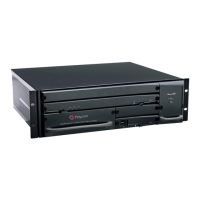Administration and Utilities
Polycom, Inc. 127
2 Click one of the following buttons to view a respective report in the System Alerts pane:
3 To save the Active Alarms, Faults Full List or Faults report:
To a text file, click Save to Text .
To an XML file, click Save to XML .
The Save to XML button is only available when logged in as a special support user.
4 Select a destination folder and enter the file name.
5 Click Save.
Category Lists the type of error. The following categories may be listed:
• File - Indicates a problem in one of the files stored on the MCU’s hard disk.
• Card - Indicates a card problem.
• Exception - Indicates a software error.
• General - Indicates a general error.
• Assert - Indicates an internal software error reported by the software.
• Startup - Indicates an error during system startup.
• Unit - Indicates a problem with a unit.
•MPL - Indicates an error related to a Shelf Management component (MPL
component) other than an MPM media card, RTM, or switch board
(Collaboration Server 2000/4000 only).
Level Indicates the severity of the problem, or the type of event. There are three fault
level indicators:
- Major Error
- System Message
- Startup Event
Code Indicates the problem, as indicated by the error category.
Process Name Lists the type of functional process involved.
Description When applicable, displays a more detailed explanation of the problem.
System Alerts Buttons
Active Alarms (default) – The default report list displayed in the System Alerts indication
bar. Contains the current system errors, and supplies a quick indication on MCU status.
Faults Full List - A full list of system faults.
Note: Viewed when logging in as a special support user.
Faults List – A list of previous faults (whether they were solved or not) for support or
debugging purposes.
Active Alarms Pane Columns
Field Description

